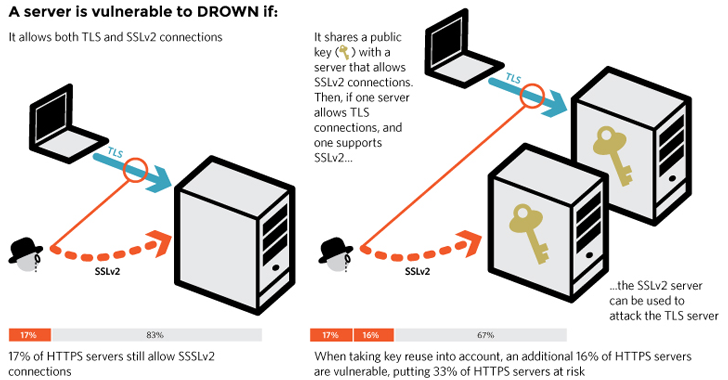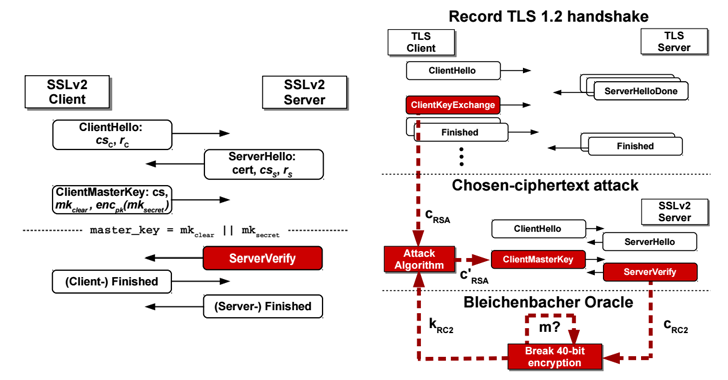More than 11 million OpenSSL HTTPS websites at risk
A new deadly security vulnerability has been discovered in OpenSSL that affects more than 11 Million modern websites and e-mail services protected by an ancient, long deprecated transport layer security protocol, Secure Sockets Layer (SSLv2).
 Dubbed DROWN, the highly critical security hole in OpenSSL was disclosed today as a low-cost attack that could decrypt your sensitive, secure HTTPS communications, including passwords and credit card details…
Dubbed DROWN, the highly critical security hole in OpenSSL was disclosed today as a low-cost attack that could decrypt your sensitive, secure HTTPS communications, including passwords and credit card details…
...and that too in a matter of hours or in some cases almost immediately, a team of 15 security researchers from various universities and the infosec community warned Tuesday. Here’s what the security researchers said: "We've been able to execute the attack against OpenSSL versions that are vulnerable to CVE-2016-0703 in under a minute using a single PC. Even for servers that do not have these particular bugs, the general variant of the attack, which works against any SSLv2 server, can be conducted in under 8 hours at a total cost of $440."
What is DROWN Attack? How it Abuses SSLv2 to attack TLS?
DROWN stands for "Decrypting RSA with Obsolete and Weakened eNcryption." DROWN is a cross-protocol attack that uses weaknesses in the SSLv2 implementation against transport layer security (TLS), and that can "decrypt passively collected TLS sessions from up-to-date clients."
While latest versions don't allow SSLv2 connections by default, administrators sometimes, unintentionally override those settings in an attempt to optimize applications. "You’re just as much at risk if your site’s certificate or key is used anywhere else on a server that does support SSLv2," security researchers noted. "Common examples include SMTP, IMAP, and POP mail servers, and secondary HTTPS servers used for specific web applications."

DROWN attack could allow an attacker to decrypt HTTPS connections by sending specially crafted malicious packets to a server or if the certificate is shared on another server, potentially performing a successful Man-in-the-Middle (MitM) attack.

More than 33 percent of all HTTPS servers are vulnerable to DROWN attack.
Although the critical flaw affects as many as 11.5 Million servers worldwide, some of Alexa's top websites, including Yahoo, Alibaba, Weibo, Sina, BuzzFeed, Flickr, StumbleUpon, 4Shared and Samsung, are vulnerable to DROWN-based MitM attacks.
Besides the open-source OpenSSL, Microsoft's Internet Information Services (IIS) versions 7 and earlier, as well as prior to 3.13 versions of the Network Security Services (NSS) Cryptographic library built into many server products are also open to DROWN attack.
How to Test DROWN OpenSSL Vulnerability?
You can find out if your website is vulnerable to this critical security hole using the DROWN attack test site. However, the good news is that academic researchers uncovered the DROWN security hole and a patch for the vulnerability has already been made available with an OpenSSL update today.
The Bad news is that the DROWN attack can conduct just under a minute to exploit and now that the bug has been disclosed, it may be actively used by hackers to attack servers.
Here’s How to Protect Yourself:
OpenSSL 1.0.2 users are strongly advised to upgrade to OpenSSL 1.0.2g and OpenSSL 1.0.1 users are recommended to upgrade to OpenSSL 1.0.1s. And if you are using another version of OpenSSL for security, you should move up to the newer versions 1.0.2g or 1.0.1s. In order to protect yourself against the DROWN attack, you should ensure SSLv2 is disabled, as well as make sure that the private key isn’t shared across any other servers.
Those already vulnerable to DROWN attack do not need to re-issue certificates but are recommended to take action in order to prevent the attack immediately. SSLv2 dates back to the 1990s-era and is enabled accidentally or automatically while setting up a new server, which makes DROWN attacks work. It’s due to the support of weak ciphers that were added to all versions of SSL and TLS prior to 2000 as part of United States government's export regulations.
In fact, "secure" servers can also be hacked because they are on the same network as vulnerable servers. By using the Bleichenbacher attack, private RSA keys can be decrypted, which results in unlocking "secure" servers that use the same private key.
You can find more technical details and a list of the top vulnerable websites on the DROWN Attack website. In addition, Matthew Green, a professor at Johns Hopkins University and famous cryptographer, has also published a blog post explaining how DROWN works.
Axarhöfði 14,
110 Reykjavik, Iceland














